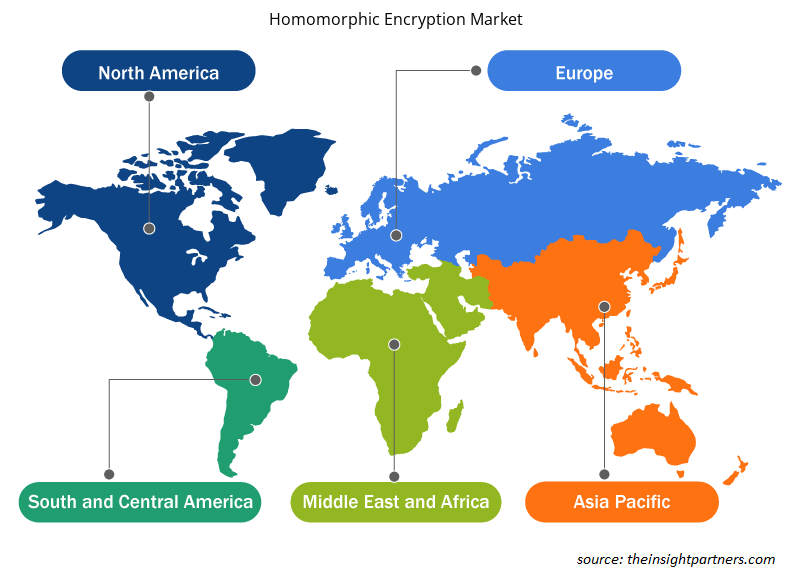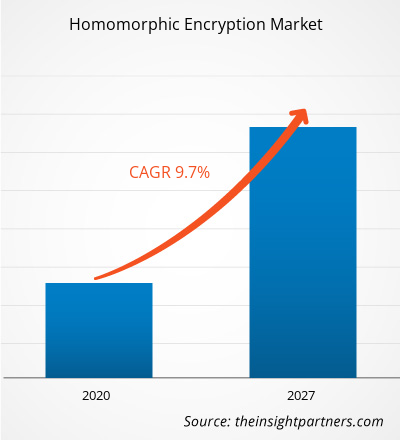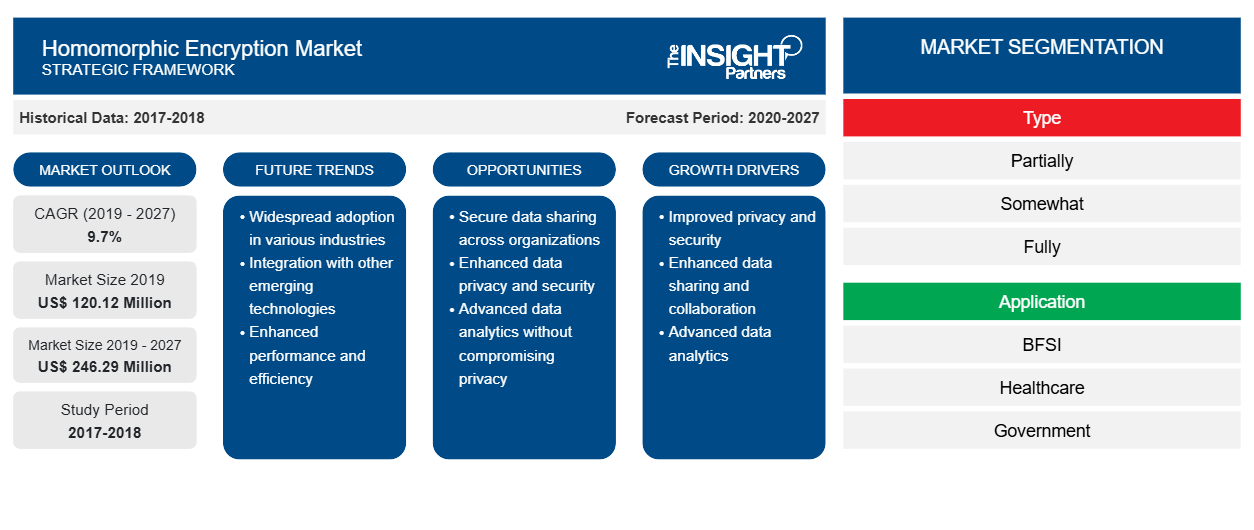Si prevede che il mercato della crittografia omomorfica raggiungerà i 246,29 milioni di dollari entro il 2027, passando dai 120,12 milioni di dollari del 2019. Il tasso di crescita per la curva dei ricavi è stimato al 9,7% durante il periodo di previsione.
L'aumento del numero di attacchi informatici in tutto il mondo è diventato una preoccupazione vitale per le organizzazioni. Poiché la maggior parte dei dati digitali viene trasferita tramite Internet e reti avanzate, il pericolo di vulnerabilità dei dati è aumentato rapidamente. Il governo, i servizi finanziari e il settore IT sono alcuni dei settori di spicco vulnerabili alle minacce informatiche. I settori menzionati sopra affrontano sfide difficili per quanto riguarda la sicurezza e la vulnerabilità dei dati, poiché devono gestire l'archiviazione, la migrazione, lo spostamento e l'outsourcing dei dati degli utenti su piattaforme open source più volte. Pertanto, al fine di mitigare il rischio relativo alla sicurezza dei dati durante la loro inattività, trasmissione o elaborazione, la crittografia omomorfica sta guadagnando terreno in vari settori. L'utilizzo della tecnologia di crittografia omomorfica consente alle organizzazioni di mantenere uno standard solido di sicurezza dei dati senza compromettere le operazioni aziendali o le funzioni delle applicazioni. Inoltre, a causa delle crescenti preoccupazioni sulla raccolta, l'uso improprio, il trasferimento o la gestione dei dati da parte di aziende e istituzioni, i governi di tutto il mondo stanno fortemente sottolineando la protezione dei dati dei consumatori, il che sta ulteriormente spingendo l'adozione della tecnologia di crittografia omomorfica. Pertanto, si prevede che la crescente preoccupazione per la sicurezza dei dati e la crescente necessità di protezione dei dati dei consumatori in tutto il mondo daranno impulso al mercato della crittografia omomorfica durante il periodo di previsione.
Personalizza questo report in base alle tue esigenze
Riceverai la personalizzazione gratuita di qualsiasi report, comprese parti di questo report, o analisi a livello nazionale, pacchetto dati Excel, oltre a usufruire di grandi offerte e sconti per start-up e università
- Scopri le principali tendenze di mercato in questo rapporto.Questo campione GRATUITO includerà analisi di dati che spaziano dalle tendenze di mercato alle stime e alle previsioni.
Impatto della pandemia di COVID-19 sul mercato della crittografia omomorfica
L'epidemia di COVID-19 sta cambiando il funzionamento delle aziende in tutto il mondo. Per ridurre la diffusione del coronavirus, aziende e governi lavorano dalla cultura che guida la digitalizzazione nel mercato globale. L'ecosistema mondiale dei dati aziendali si è dimostrato forte di fronte all'epidemia. Le aziende, gli ospedali e altri servizi governativi hanno iniziato ad adottare piattaforme digitali con funzionalità di sicurezza garantite. Tuttavia, i servizi del settore finanziario stanno adottando tecnologie di crittografia avanzate per offrire ai clienti servizi elettronici protetti. I progetti di digitalizzazione hanno assistito a una crescita in calo all'inizio della pandemia a causa delle restrizioni finanziarie, ma dopo il blocco l'importanza è aumentata a un ritmo significativo. Le transazioni di dati si sono evolute in una qualità enorme che ha creato domanda per i servizi di crittografia.
Approfondimenti di mercato
Crescente diffusione del cloud computing
Con l'emergere del cloud computing, la rete on-premise sta scomparendo. Grazie ai numerosi vantaggi del cloud computing, come costi, flessibilità, scalabilità, mobilità, disaster recovery e prevenzione delle perdite, insieme alla riduzione dei costi del cloud computing, le organizzazioni stanno rapidamente adottando il cloud computing. Tuttavia, mitigare il database sul cloud è sempre stata una questione di preoccupazione. Sebbene la crittografia dei dati sia considerata un'opzione praticabile, è comunque esposta a rischi durante l'elaborazione, poiché i dati devono essere prima decrittografati. La crittografia omomorfica consente alle organizzazioni di elaborare i dati mantenendoli sempre crittografati. Consente agli utenti di eseguire calcoli complessi e di grandi dimensioni senza compromettere la sicurezza dei dati. Grazie all'aumento dell'implementazione del cloud computing in tutto il mondo e alla necessità di un cloud computing sicuro, si prevede che il mercato della crittografia omomorfica assisterà a significative opportunità di crescita nei prossimi anni.
Tipo Approfondimenti di mercato
La crittografia omomorfica analizza i dati crittografati senza rivelare le informazioni a nessuno. Ha un potenziale enorme in aree con dati personali sensibili, come l'assistenza sanitaria e i servizi finanziari, quando la privacy di una persona è fondamentale. In queste situazioni, la tecnologia di crittografia omomorfica salvaguarda i dettagli sensibili dei dati effettivi. La crittografia omomorfica è differenziata in base ai tipi e alla frequenza delle operazioni matematiche che possono essere implementate sul testo cifrato. I tipi di crittografia omomorfica includono parzialmente, in parte e completamente.
Approfondimento del mercato delle applicazioni
L'uso crescente di soluzioni di mobilità e smartphone sta alimentando il mercato poiché il cloud computing mobile è un'infrastruttura in cui sia l'elaborazione dei dati che l'archiviazione dei dati avvengono all'esterno del dispositivo. Attualmente, a causa dell'adozione della digitalizzazione in tutte le regioni, i consumatori utilizzano gli smartphone nella loro vita quotidiana per il mobile banking, lo shopping e il pagamento delle bollette. Pertanto, condividono i loro dati personali con un forum di terze parti che solleva preoccupazioni sulla privacy dei dati di un individuo. Gli utenti Internet in crescita in tutto il mondo stanno condividendo enormi informazioni tramite un mezzo di terze parti. Pertanto, la sicurezza dei dati diventa un fattore cruciale che sta accelerando la crescita del mercato della crittografia omomorfica. La crittografia omomorfica aiuta ad affrontare l'equilibrio tra rischio e utilità nella condivisione dei dati per varie applicazioni industriali, come BFSI, assistenza sanitaria e governo.
Gli attori che operano nel mercato dell'enterprise content management si concentrano su strategie quali fusioni, acquisizioni e iniziative di mercato per mantenere le loro posizioni nel mercato. Di seguito sono elencati alcuni sviluppi da parte degli attori chiave:
- Nell'aprile 2020, ZAMA ha raccolto fondi da Lunar Ventures e Plug and Play, ma i dettagli finanziari non sono stati resi noti.
- Nel febbraio 2020, Netskope Inc. ha raccolto 340 milioni di dollari nel round di finanziamento di serie G e l'investimento è stato guidato da Sequoia Capital.
Approfondimenti regionali sul mercato della crittografia omomorfica
Le tendenze regionali e i fattori che influenzano il mercato della crittografia omomorfica durante il periodo di previsione sono stati ampiamente spiegati dagli analisti di Insight Partners. Questa sezione discute anche i segmenti e la geografia del mercato della crittografia omomorfica in Nord America, Europa, Asia Pacifico, Medio Oriente e Africa e America meridionale e centrale.

- Ottieni i dati specifici regionali per il mercato della crittografia omomorfica
Ambito del rapporto di mercato sulla crittografia omomorfica
| Attributo del report | Dettagli |
|---|---|
| Dimensioni del mercato nel 2019 | 120,12 milioni di dollari USA |
| Dimensioni del mercato entro il 2027 | 246,29 milioni di dollari USA |
| CAGR globale (2019 - 2027) | 9,7% |
| Dati storici | 2017-2018 |
| Periodo di previsione | 2020-2027 |
| Segmenti coperti | Per tipo
|
| Regioni e Paesi coperti | America del Nord
|
| Leader di mercato e profili aziendali chiave |
|
Densità degli attori del mercato della crittografia omomorfica: comprendere il suo impatto sulle dinamiche aziendali
Il mercato della crittografia omomorfica sta crescendo rapidamente, spinto dalla crescente domanda degli utenti finali dovuta a fattori quali l'evoluzione delle preferenze dei consumatori, i progressi tecnologici e una maggiore consapevolezza dei vantaggi del prodotto. Con l'aumento della domanda, le aziende stanno ampliando le loro offerte, innovando per soddisfare le esigenze dei consumatori e capitalizzando sulle tendenze emergenti, il che alimenta ulteriormente la crescita del mercato.
La densità degli operatori di mercato si riferisce alla distribuzione di aziende o società che operano in un particolare mercato o settore. Indica quanti concorrenti (operatori di mercato) sono presenti in un dato spazio di mercato in relazione alle sue dimensioni o al valore di mercato totale.
Le principali aziende che operano nel mercato della crittografia omomorfica sono:
- Cosmiano
- Esperti di criptovalute SAS
- Società a responsabilità limitata Google LLC
- Società IBM
- Società a responsabilità limitata
Disclaimer : le aziende elencate sopra non sono classificate secondo un ordine particolare.

- Ottieni una panoramica dei principali attori del mercato della crittografia omomorfica
Segmenti di crittografia omomorfica globale:
Mercato della crittografia omomorfica – Per tipo
- Parzialmente
- Un po'
- Completamente
Mercato della crittografia omomorfica – Per applicazione
- BFSI
- Assistenza sanitaria
- Governo
- Altri
Mercato della crittografia omomorfica – Per area geografica
America del Nord
- NOI
- Canada
- Messico
Europa
- Francia
- Germania
- Italia
- Spagna
- Regno Unito
- Resto d'Europa
Asia Pacifico (APAC)
- Australia
- Cina
- India
- Giappone
- Resto dell'APAC
Medio Oriente e Africa (MEA)
- Arabia Saudita
- Emirati Arabi Uniti
- Sudafrica
- Resto del MEA
America del Sud (SAM)
- Brasile
- Resto del SAM
Aziende
- Cosmiano
- Esperti di criptovalute SAS
- Società a responsabilità limitata
- ShieldIO, Inc.
- ZAMA
- Società Microsoft
- Netskope, Inc.
- Gruppo Talete
- Società IBM
- Società a responsabilità limitata Google LLC
- Analisi storica (2 anni), anno base, previsione (7 anni) con CAGR
- Analisi PEST e SWOT
- Valore/volume delle dimensioni del mercato - Globale, Regionale, Nazionale
- Industria e panorama competitivo
- Set di dati Excel
Report recenti
Testimonianze
Motivo dell'acquisto
- Processo decisionale informato
- Comprensione delle dinamiche di mercato
- Analisi competitiva
- Analisi dei clienti
- Previsioni di mercato
- Mitigazione del rischio
- Pianificazione strategica
- Giustificazione degli investimenti
- Identificazione dei mercati emergenti
- Miglioramento delle strategie di marketing
- Aumento dell'efficienza operativa
- Allineamento alle tendenze normative





















 Ottieni un campione gratuito per - Mercato della crittografia omomorfica
Ottieni un campione gratuito per - Mercato della crittografia omomorfica